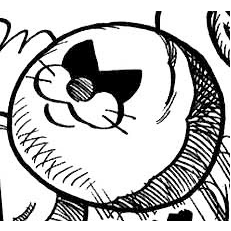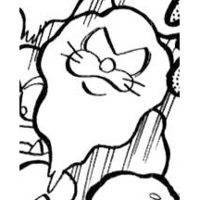Choropū Men'iwa: Difference between revisions
From the Super Mario Wiki, the Mario encyclopedia
Jump to navigationJump to search
No edit summary |
m (Text replacement - "Fra([AE]?M? *)=" to "Fre$1=") |
||
| (6 intermediate revisions by 5 users not shown) | |||
| Line 1: | Line 1: | ||
{{another language}} | {{another language}} | ||
{{species | {{species infobox | ||
|image=[[File:Monty Mole Stone Spirit SM-k.png|231px]] | |image=[[File:Monty Mole Stone Spirit SM-k.png|231px]] | ||
| | |variant_of=[[Monty Mole]] | ||
|first_appearance=''[[Super Mario-kun]]'' (volume 5) (1992) | |first_appearance=''[[Super Mario-kun]]'' (volume 5) (1992) | ||
}} | }} | ||
{{quote|にがさんぞ~~!! ("Don't try to escape...!!")|Choropū Men'iwa|Super Mario-kun}} | {{quote|にがさんぞ~~!! ("Don't try to escape...!!")|Choropū Men'iwa|Super Mario-kun}} | ||
[[File:Monty Mole Stone Spirit True Form SM-k.png|thumb|left|A Choropū Men'iwa when its rock body is broken, revealing its true form]] | [[File:Monty Mole Stone Spirit True Form SM-k.png|thumb|left|A Choropū Men'iwa when its rock body is broken, revealing its true form]] | ||
'''Choropū Men'iwa''' | '''Choropū Men'iwa''' are undead variants of Monty Moles that appear in volume 5 of ''[[Super Mario-kun]]''. They resemble stones with Monty Mole faces, but when they are broken, they resemble ghosts with Monty Mole faces. | ||
When [[Mario]] is in the graveyard, he meets the Choropū Men'iwa alongside other face rock enemies. They fly towards Mario before attacking him. Mario opens [[Yoshi]]'s mouth to make him eat the Choropū Men'iwa, then punches Yoshi's mouth to break them. The spirits of the enemies including the Monty Moles fly out, now resembling ghosts. | When [[Mario]] is in the graveyard, he meets the Choropū Men'iwa alongside other face rock enemies. They fly towards Mario before attacking him. Mario opens [[Yoshi]]'s mouth to make him eat the Choropū Men'iwa, then punches Yoshi's mouth to break them. The spirits of the enemies including the Monty Moles fly out, now resembling ghosts. | ||
{{br|left}} | {{br|left}} | ||
==Names in other languages== | |||
{{Foreign names | |||
|Jap=チョロプー面岩<ref>''Super Mario-kun'', volume 5, chapter 11 (page 154)</ref> | |||
|JapR=Choropū Men'iwa | |||
|JapM=[[Monty Mole]] Face Rocks | |||
|Fre=Topi Taupe en pierre<ref>[[Super Mario-kun|Super Mario Manga Adventures]] Volume 5, page 154</ref> | |||
|FreM=Stone Monty Mole | |||
}} | |||
==References== | ==References== | ||
Latest revision as of 06:51, January 8, 2024
The title of this article is official, but it comes from a non-English source. If an acceptable English source is found, then the article should be moved to its appropriate title.
| Choropū Men'iwa | |
|---|---|

| |
| First appearance | Super Mario-kun (volume 5) (1992) |
| Variant of | Monty Mole |
- “にがさんぞ~~!! ("Don't try to escape...!!")”
- —Choropū Men'iwa, Super Mario-kun
Choropū Men'iwa are undead variants of Monty Moles that appear in volume 5 of Super Mario-kun. They resemble stones with Monty Mole faces, but when they are broken, they resemble ghosts with Monty Mole faces.
When Mario is in the graveyard, he meets the Choropū Men'iwa alongside other face rock enemies. They fly towards Mario before attacking him. Mario opens Yoshi's mouth to make him eat the Choropū Men'iwa, then punches Yoshi's mouth to break them. The spirits of the enemies including the Monty Moles fly out, now resembling ghosts.
Names in other languages[edit]
| Language | Name | Meaning |
|---|---|---|
| Japanese | チョロプー面岩[1] Choropū Men'iwa |
Monty Mole Face Rocks |
| French | Topi Taupe en pierre[2] |
Stone Monty Mole |
References[edit]
- ^ Super Mario-kun, volume 5, chapter 11 (page 154)
- ^ Super Mario Manga Adventures Volume 5, page 154
| Monty Moles and relatives | |
|---|---|
| Characters | Big Montgomery • Chitei Kaijū Indy • Choropū Chika Butai • Choropū (Haha) • Choropū (Kodomo-tachi) • Choropū-san • Choropū Shinrin-tai • Choropū the Picasso • Choropūko • Chorozairu • Gattai monster • Monty Bros. • Monty Mole auctioneer • Monty Tank • Pakkun Mogura • Pūko • Sphinx Zō |
| Species | Big Monty Mole • Choropū Men'iwa • Mawful Mole • Mega Mole • Metal Mawful Mole • Mole (presenter) • Monty Mole • Monty Mole (Flower Fields) • Monty Mole Patch • Monty Mole Swooper • Morty Mole |
| Other relatives | Ragumo • Rocky Wrench |
